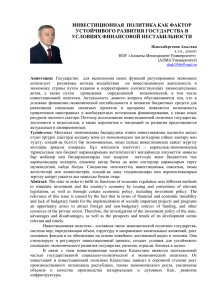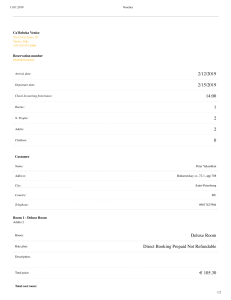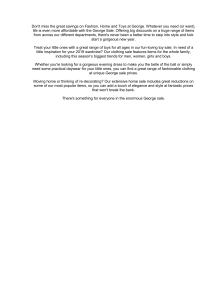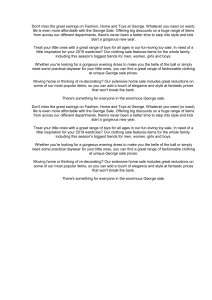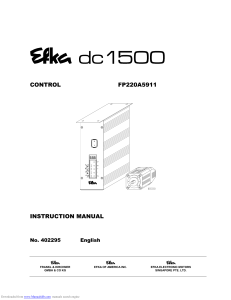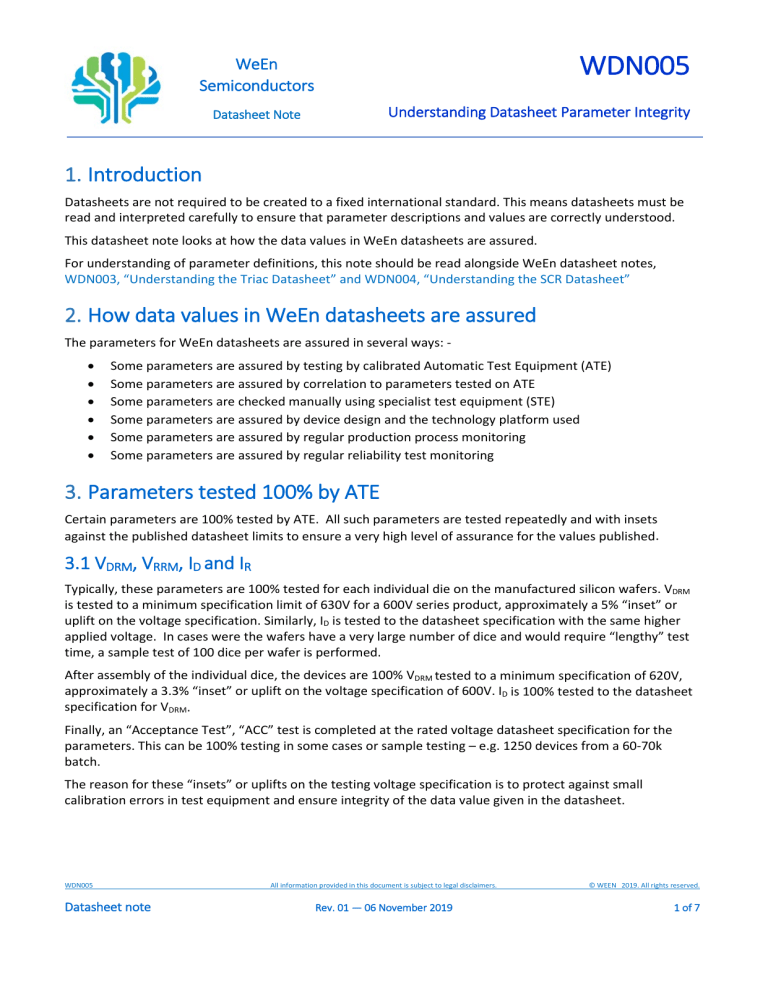
WDN005 WeEn Semiconductors Understanding Datasheet Parameter Integrity Datasheet Note 1. Introduction Datasheets are not required to be created to a fixed international standard. This means datasheets must be read and interpreted carefully to ensure that parameter descriptions and values are correctly understood. This datasheet note looks at how the data values in WeEn datasheets are assured. For understanding of parameter definitions, this note should be read alongside WeEn datasheet notes, WDN003, “Understanding the Triac Datasheet” and WDN004, “Understanding the SCR Datasheet” 2. How data values in WeEn datasheets are assured The parameters for WeEn datasheets are assured in several ways: • • • • • • Some parameters are assured by testing by calibrated Automatic Test Equipment (ATE) Some parameters are assured by correlation to parameters tested on ATE Some parameters are checked manually using specialist test equipment (STE) Some parameters are assured by device design and the technology platform used Some parameters are assured by regular production process monitoring Some parameters are assured by regular reliability test monitoring 3. Parameters tested 100% by ATE Certain parameters are 100% tested by ATE. All such parameters are tested repeatedly and with insets against the published datasheet limits to ensure a very high level of assurance for the values published. 3.1 VDRM, VRRM, ID and IR Typically, these parameters are 100% tested for each individual die on the manufactured silicon wafers. VDRM is tested to a minimum specification limit of 630V for a 600V series product, approximately a 5% “inset” or uplift on the voltage specification. Similarly, ID is tested to the datasheet specification with the same higher applied voltage. In cases were the wafers have a very large number of dice and would require “lengthy” test time, a sample test of 100 dice per wafer is performed. After assembly of the individual dice, the devices are 100% VDRM tested to a minimum specification of 620V, approximately a 3.3% “inset” or uplift on the voltage specification of 600V. ID is 100% tested to the datasheet specification for VDRM. Finally, an “Acceptance Test”, “ACC” test is completed at the rated voltage datasheet specification for the parameters. This can be 100% testing in some cases or sample testing – e.g. 1250 devices from a 60-70k batch. The reason for these “insets” or uplifts on the testing voltage specification is to protect against small calibration errors in test equipment and ensure integrity of the data value given in the datasheet. WDN005 Datasheet note All information provided in this document is subject to legal disclaimers. Rev. 01 — 06 November 2019 © WEEN 2019. All rights reserved. 1 of 7 WDN005 WeEn Semiconductors Understanding Datasheet Parameter Integrity 3.2 IGT Maximum gate trigger current IGT (max) is a triac’s or SCR’s triggering need or requirement. The triggering circuit must apply at least this value of gate current to guarantee triggering the triac. If a minimum value is given in the datasheet, this indicates that current below that level – e.g. electrical noise will not trigger the SCR or triac. It is important to understand these values are stated for 25 οC. IGT increases as junction temperature decreases and so in order to guarantee reliable triggering of the triac or SCR, the designer needs set the gate drive current for the lowest operating temperature for the application. The minimum recommended gate pulse width for reliable triggering is 10µs. Typically, this parameter is also 100% tested for each individual die on the manufactured silicon wafers with an “inset”. In the example above, the testing would be to a 38.5mA limit. After assembly, the devices are 100% tested to within 3% for the gate current specification with a 48.5mA limit. A final “outgoing inspection test” is completed to the datasheet specification limit of 50mA. Similar appropriate insets are applied for any minimum limits also. 3.3 VT VT is the on-state voltage at 25 C for a specified load current condition. This is the maximum instantaneous on-state voltage, measured under pulse conditions to avoid excessive power dissipation. High current testing on wafers cannot be done accurately so although for low currents this parameter is 100% tested, for higher current devices the wafers are sample tested using 1250 devices from a batch of 60-70K devices. All assembled product is 100% tested after assembly. 4. Parameters correlated to those tested 100% by ATE 4.1 VGT, IH, IL These are parameters which sometimes cannot be 100% tested in the production process but are protected by correlation with those parameters that can be tested. The “physics” governing the behaviour of triacs is such that there is a very good correlation for these “sensitivity related” parameters with IGT. The IGT parameter is 100% ATE tested as described previously but it is understood that “correlation” between two parameters will always be subject to some spread in values and can vary a little in the volume production environment. Consequently, the maximum limits of such parameters in data are set such that there is a WDN005 Datasheet note All information provided in this document is subject to legal disclaimers. Rev. 01— 06 November 2019 © WEEN 2019. All rights reserved. 2 of 7 WDN005 WeEn Semiconductors Understanding Datasheet Parameter Integrity significant safety margin. This means that the maximum limit for the IGT testing will protect the data maximum limits on VGT, IH and IL with plenty of “headroom”. At wafer stage these parameters are 100% tested whilst in other situations where numbers of dice may be very large the devices are sample tested using 1250 devices from a batch of 60-70K devices. All assembled product is 100% tested. 5. Parameters checked manually with specialist test equipment 5.1 dVD/dt, dVcom/dt, dIcom/dt The parameters related to “false trigger immunity” are dynamic parameters and these also have their values in data protected by correlation to other sensitivity related parameters such as IGT which are 100% ATE tested. Although these dynamic parameters cannot be 100% tested on ATE, specialist manual or semi-automatic test methods are used for checking individual assembled devices to confirm the published data limits. These false trigger immunity related parameters of off-state dVD/dt and commutation parameters dVcom/dt and dIcom/dt are protected by correlation against a minimum limit on IGT (or a minimum limit of an “IGT derived parameter through some calculation formula”). This IGT minimum limit is 100% tested. The limit is set in data to ensure there is plenty of “headroom” or safety margin where correlation is used. The minimum, typical and maximum values for each parameter are based on measurements of deliberately large spread trials to produce devices at WeEn’s process-window limits. From these measurements, a value measured as a “minimum” represents what the worst-case device in the production-spread would be. However, the guaranteed minimum as shown in the datasheet is set at a value a little lower than this measured worst-case performance. This gives designers a further extra safety margin. Similarly, the values measured as “maximum” are a measure of the best-case performance in the production-spread of devices. They do not represent guaranteed maximum values. A guaranteed maximum is not of use to designers in a circuit application because the guaranteed minimum is the important parameter for “false trigger immunity”. It is possible however to make a rough inference that if the measured parameters are a normal gaussianshaped distribution (this is normally the case for production-spreads), then the maximum value should roughly be higher than the typical value by as much as the minimum value is below the typical. 6. Parameters and ratings protected by design and technology 6.1 Tj (max), Tstg (max), ITSM, dIT/dt, PGM, PG(AV), IGM, Rth Certain parameters and ratings are inherent to the wafer manufacturing and package assembly technology. These are therefore protected by design. The temperature ratings have been tested extensively through zero hour and reliability testing as well as also regularly checked with WeEn’s routine monitoring life testing program. Other ratings such as ITSM, turn-on dIT/dt, gate ratings and thermal resistance, Rth are specified in accordance with silicon chip design (MT1 or Anode, MT2 or Cathode and gate structure) as well as assembly methods for the finished device. The rules for setting limits on these parameters apply across a whole range of products within WeEn’s triac technology family. WDN005 Datasheet note All information provided in this document is subject to legal disclaimers. Rev. 01 — 06 November 2019 © WEEN 2019. All rights reserved. 3 of 7 WDN005 WeEn Semiconductors Understanding Datasheet Parameter Integrity 7. Parameters assured by constant production process monitoring Certain tests are carried out to monitor the production process and certain parameters are tested which are not included in the published datasheet. This assures the reliability and integrity of the production and assembly processes. These tests are done regularly as sample tests or 100% tests. For example, a parameter called “deltaVT” is used to monitor and indicate die attach quality after assembly. In another example, Qs is a measure of stored charge for SCRs and is a wafer tested to a minimum limit (whether 100% ATE or manual). This protects against wafers having low Qs due to incoming wafer quality or process issues (such as contamination). In this example, the minimum Qs limit is to protect other parameters in the final product, such as ITSM in SCRs. Ultrafast diodes with a maximum Qs/trr specification in the datasheet would normally have a 100% maximum Qs or trr test to protect this parameter. In some cases, this is done by a “minimum VF” test. At the wafer test stage this is usually done manually on a few points per wafer to “protect assembly yields”, by ensuring wafers delivered for assembly are not wrongly processed. 8. Parameters assured by regular reliability test monitoring Routine reliability test monitoring is performed every 3 months. A sample selection of devices with similar structure are chosen for these tests. Each technology platform with every package type is included in the choice. Six to seven reliability tests are carried out for each selected product type using 80 devices with control samples. 9. Product reliability robustness – a pictorial view Product Specification limits Circuit Design Limits Fig 1. Representation of data integrity and relationship with capability, data limits and circuit design limits WDN005 Datasheet note All information provided in this document is subject to legal disclaimers. Rev. 01— 06 November 2019 © WEEN 2019. All rights reserved. 4 of 7 WDN005 WeEn Semiconductors Understanding Datasheet Parameter Integrity Revision history Rev v.01 Date 20191106 Description initial version Contact information For more information and sales office addresses please visit: http://www.ween-semi.com WDN005 Datasheet note All information provided in this document is subject to legal disclaimers. Rev. 01 — 06 November 2019 © WEEN 2019. All rights reserved. 5 of 7 WDN005 WeEn Semiconductors Understanding Datasheet Parameter Integrity Legal information Definitions Draft — The document is a draft version only. The content is still under internal review and subject to formal approval, which may result in modifications or additions. WeEn Semiconductors does not give any representations or warranties as to the accuracy or completeness of information included herein and shall have no liability for the consequences of use of such information. Disclaimers Limited warranty and liability — Information in this document is believed to be accurate and reliable. However, WeEn Semiconductors does not give any representations or warranties, expressed or implied, as to the accuracy or completeness of such information and shall have no liability for the consequences of use of such information. WeEn Semiconductors takes no responsibility for the content in this document if provided by an information source outside of WeEn Semiconductors. In no event shall WeEn Semiconductors be liable for any indirect, incidental, punitive, special or consequential damages (including - without limitation - lost profits, lost savings, business interruption, costs related to the removal or replacement of any products or rework charges) whether or not such damages are based on tort (including negligence), warranty, breach of contract or any other legal theory. Notwithstanding any damages that customer might incur for any reason whatsoever, WeEn Semiconductors’ aggregate and cumulative liability towards customer for the products described herein shall be limited in accordance with the Terms and conditions of commercial sale of WeEn Semiconductors. Right to make changes —WeEn Semiconductors reserves the right to make changes to information published in this document, including without limitation specifications and product descriptions, at any time and without notice. This document supersedes and replaces all information supplied prior to the publication hereof. Suitability for use — WeEn Semiconductors products are not designed, authorized or warranted to be suitable for use in life support, life-critical or safety-critical systems or equipment, nor in applications where failure or malfunction of an WeEn Semiconductors product can reasonably be expected to result in personal injury, death or severe property or environmental damage. WeEn Semiconductors and its suppliers accept no liability for inclusion and/or use of WeEn Semiconductors products in such equipment or applications and therefore such inclusion and/or use is at the customer’s own risk. Applications — Applications that are described herein for any of these products are for illustrative purposes only. WeEn Semiconductors makes no representation or warranty that such applications will be suitable for the specified use without further testing or modification. WeEn Semiconductors does not accept any liability related to any default, damage, costs or problem which is based on any weakness or default in the customer’s applications or products, or the application or use by customer’s third-party customer(s). Customer is responsible for doing all necessary testing for the customer’s applications and products using WeEn Semiconductors products in order to avoid a default of the applications and the products or of the application or use by customer’s third-party customer(s). WeEn does not accept any liability in this respect. Export control — This document as well as the item(s) described herein may be subject to export control regulations. Export might require a prior authorization from competent authorities. Evaluation products — This product is provided on an “as is” and “with all faults” basis for evaluation purposes only. WeEn Semiconductors, its affiliates and their suppliers expressly disclaim all warranties, whether express, implied or statutory, including but not limited to the implied warranties of non-infringement, merchantability and fitness for a particular purpose. The entire risk as to the quality, or arising out of the use or performance, of this product remains with customer. In no event shall WeEn Semiconductors, its affiliates or their suppliers be liable to customer for any special, indirect, consequential, punitive or incidental damages (including without limitation damages for loss of business, business interruption, loss of use, loss of data or information, and the like) arising out the use of or inability to use the product, whether or not based on tort (including negligence), strict liability, breach of contract, breach of warranty or any other theory, even if advised of the possibility of such damages. Notwithstanding any damages that customer might incur for any reason whatsoever (including without limitation, all damages referenced above and all direct or general damages), the entire liability of WeEn Semiconductors, its affiliates and their suppliers and customer’s exclusive remedy for all of the foregoing shall be limited to actual damages incurred by customer based on reasonable reliance up to the greater of the amount actually paid by customer for the product or five dollars (US$5.00). The foregoing limitations, exclusions and disclaimers shall apply to the maximum extent permitted by applicable law, even if any remedy fails of its essential purpose. Translations — A non-English (translated) version of a document is for reference only. The English version shall prevail in case of any discrepancy between the translated and English versions. Trademarks Notice: All referenced brands, product names, service names and trademarks are the property of their respective owners. Customers are responsible for the design and operation of their applications and products using WeEn Semiconductors products, and WeEn Semiconductors accepts no liability for any assistance with applications or customer product design. It is customer’s sole responsibility to determine whether the WeEn Semiconductors product is suitable and fit for the customer’s applications and products planned, as well as for the planned application and use of customer’s third-party customer(s). Customers should provide appropriate design and operating safeguards to minimize the risks associated with their applications and products. WDN005 Datasheet note All information provided in this document is subject to legal disclaimers. Rev. 01— 06 November 2019 © WEEN 2019. All rights reserved. 6 of 7 WDN005 WeEn Semiconductors Understanding Datasheet Parameter Integrity Contents 1. Introduction ..........................................................................................................................................................................1 2. How data values in WeEn datasheets are assured ................................................................................................................. 1 3. Parameters tested 100% by ATE ............................................................................................................................................ 1 4. Parameters correlated to those tested 100% by ATE .............................................................................................................. 2 5. Parameters checked manually with specialist test equipment ............................................................................................... 3 5.1 dVD/dt, dVcom/dt, dIcom/dt ......................................................................................................................................................3 6. Parameters and ratings protected by design and technology ................................................................................................. 3 6.1 Tj(max), Tstg(max), ITSM, dIT/dt, PGM, PG(AV), IGM, Rth, ....................................................................................................................... 3 7. Parameters assured by constant production process monitoring ........................................................................................... 4 8. Parameters assured by regular reliability test monitoring ...................................................................................................... 4 9. Product reliability robustness – a pictorial view ..................................................................................................................... 4 Revision history and contact information ........................................................................................................................................... 5 Legal information ................................................................................................................................................................................6 Definitions ..................................................................................................................................................................................................... 6 Disclaimers .................................................................................................................................................................................................... 6 Trademarks ................................................................................................................................................................................................... 6 Contents .............................................................................................................................................................................................7 Please be aware that important notices concerning this document and the product(s) described herein, have been included in section ‘Legal information. © WeEn 2019. All rights reserved For more information, please visit: http://www.ween-semi.com Date of release: 06November 2019 Document identifier: WDN005_Rev01
